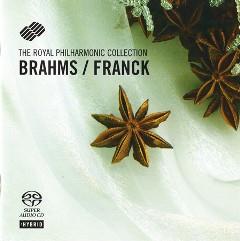Johannes Brahms César Franck - Sonatas for violin and piano (1995)
Johannes Brahms César Franck - Sonatas for violin and piano (1995)

Johannes Brahms - Sonata for violin and piano No. 1 in G major, Op. 78 01. I. Vivace ma non troppo 02. II. Adagio 03. III. Allegro molto moderato César Franck - Sonata for violin and piano in A major 04. I. Allegro ben moderato 05. II. Allegro 06. III. Recitativo. Fantasia_ Ben moderato. Largamento con fantasia 07. IV. Allegretto poco mosso Jonathan Carney - violin Ronan O'Hora - piano
If much of Brahms’s mature instrumental music suggests songs, nowhere is the connection more explicit than in the G major sonata. Its third, and final, movement is based on Brahms’s song ‘Regenlied’ (‘Rain Song’), Op 59 No 3, to a text by his fellow North German, Klaus Groth. The poem recalls rich childhood memories, triggered by the patter of rain on the window-pane, and obviously evoked powerful memories in Brahms as well. Not only does the melody, which is in the minor key, possess a wistful, longing character, but it is used again in the following song of the opus, ‘Nachklang’ (‘Echo’), to another of Groth’s poems where the imagery is turned to bleaker ends, now directly addressing vanished youth. The possibilities of recollection are naturally taken much further in the sonata. Here the melody itself (now in G minor) is extended to serve as a complete subject, leading to a transition and second theme to complete the exposition of a rondo, with constant allusions to the dotted figure of the opening. But the allusions extend beyond this movement.
The very opening of the sonata has this rhythm, and Brahms extends it into a wholly distinctive, yet complementary theme, this time more expansive, as befits the first subject of a sonata form. The link to the finale is yet further strengthened when another variant of the dotted rhythm appears towards the end of the development, now stressing G minor before the reprise restores G major. But the composer is not content only to play with the wistful recall of the idea—as he is to do even more with the theme of the finale in its closing bars. G minor opens up the possibility of E flat as a closely related key, and this is where Brahms places his soulful ‘Adagio’, an almost funereal movement where the sense of loss is at its greatest. So what a surprise it is when this very theme reappears (in E flat major again) as the central idea of the Rondo, now at ‘allegro’ tempo, and given to the violin, its winging sequel seeming to sing of resolution, of joyful acceptance, a quality deeply endorsed in the closing bars where it merges with the dotted figure in a tranquil recollection, the happiest memories of the ‘Regenlied’ now seeming to pervade all. ---Michael Musgrave, hyperion-records.co.uk
Aside from the Symphony in D minor, which has become a staple of the concert hall, the Violin Sonata (1886) is Franck's best-known work, and rightly so: It is a superb synthesis of Franck's own uniquely rich harmonic language and thematic cyclicism and the Viennese Classical tradition that he came to hold so dear in the later stages of his career.
The Sonata was composed as a wedding present for the famous Belgian violinist Eugene Ysaÿe, who performed it at his matrimonial celebrations on September 26, 1886. The work's popularity is suggested by the number and variety of arrangements that were eventually made, including versions for flute, cello, viola, and even tuba; of these, however, only the arrangement for cello received the composer's stamp of approval.
The Sonata begins not with a fiery quick movement, but rather with a poetic Allegretto moderato in 9/8 time. After a tentative opening gesture, the music builds to a compelling fortissimo climax. As the violin rejoins the discourse, the drama ebbs to a dolcissimo reprise of the opening. Another climax, this time moving toward the tonic A major, follows, and the movement ends with a brief codetta.
The tender relief of the first movement's conclusion is extremely short-lived, however, as a low sixteenth note rumbling in the piano soon overflows into a full-blooded Allegro. The syncopated main tune is taken over by the violin, and things settle down just long enough for a quasi lento interlude and some fragmented episodic reconstructions of the movement's three main motivic strands. A recapitulation, with suitable harmonic reorganization of the material, follows, and the coda, initially misterioso but increasingly tumultuous, provides an electrifying finish.
The third movement, Recitativo-Fantasia, is in many ways the most immediately striking in the Sonata. The piano makes an introductory gesture that draws on the same rising-third gesture that provided the first movement's main theme, to which the violin responds unaccompanied. The tranquil, almost other-worldly middle section introduces the two striving themes, with characteristic triplet-rhythm accompaniment, that will return in glorious attire in the Finale.
The total defeat that seems to mark the conclusion of the third movement is immediately dispelled by the happy opening of the Finale. Although the initial melody, treated in exact canonic imitation between the instruments, is original to the last movement, the first of the two melodies from the central section of the third movement also makes a return. After an appropriate mingling of these ideas -- and a colorful interlude built on a subsidiary motive from the opening movement -- a tremendous buildup climaxes in the passionate fortissimo return of the second of the two third-movement themes and is immediately repeated a whole step higher. As the dam bursts the opening canonic theme returns once more to bring the work to a cheerful close. ---Blair Johnston, allmusic.com
download (mp3 @320 kbs):
yandex 4shared mega mediafire uloz.to cloudmailru gett








